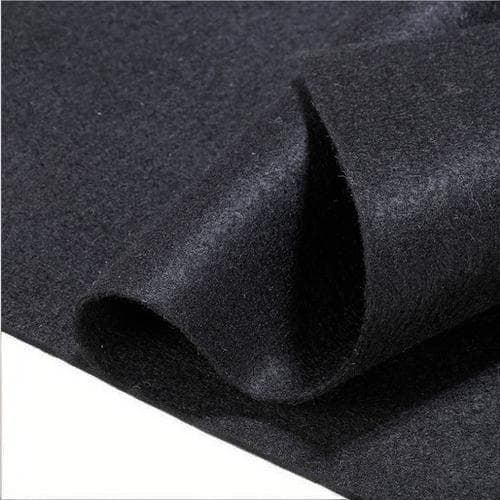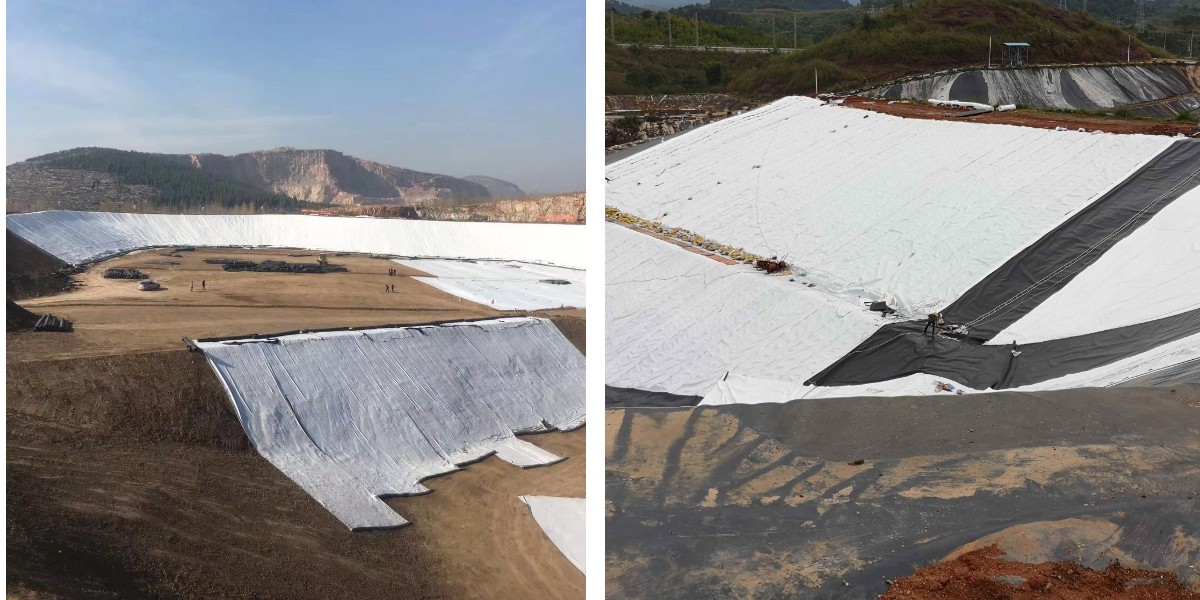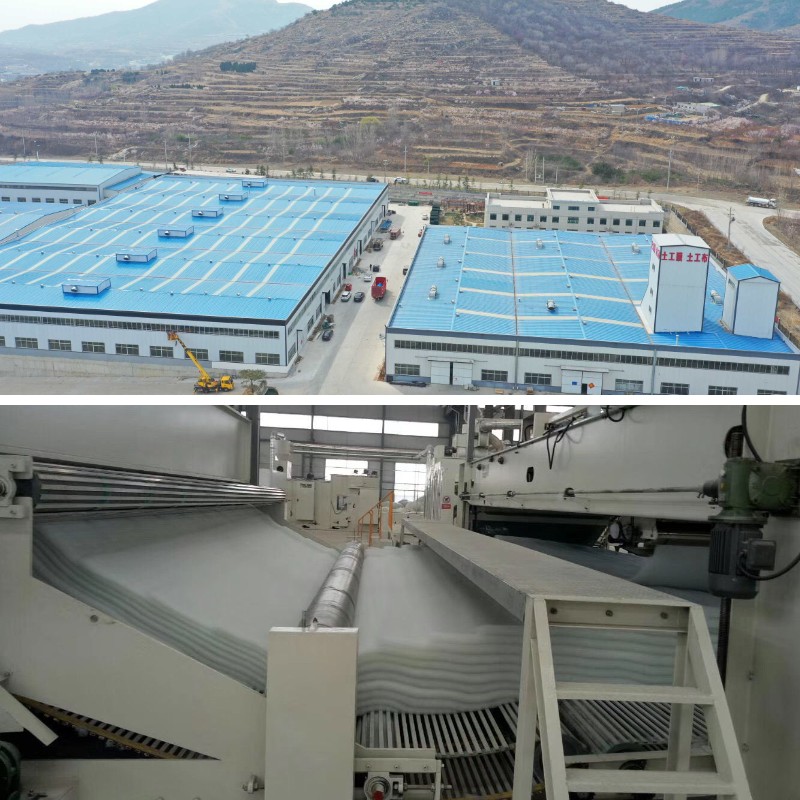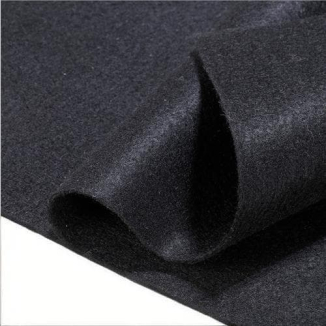Geotextile Slope Stabilization
1. Strengthen the integrity of the slope: By tightly combining the fiber interwoven structure with the soil, the shear strength of the slope surface is enhanced, soil slip is suppressed, and the slope shape is stabilized.
2. Soil and water conservation and erosion prevention: intercept soil particles lost on the slope, while allowing water infiltration to reduce the erosion and damage of the slope caused by rainwater erosion.
3. Adapt to terrain and settlement: Strong flexibility, can fit complex slope contours, withstand small settlement deformations of slopes, and avoid material tearing and failure.
4. Assist in vegetation restoration: provide attachment carriers for plant roots, further reinforce slopes in conjunction with vegetation growth, and achieve dual ecological and protective effects.
Products Introduction:
Geotextile Slope Stabilization is a high-performance geosynthetic material designed specifically for slope reinforcement and protection. It is made of high-strength polyester, polypropylene and other polymer fibers as the core raw materials, processed through needle punching, weaving or composite processes, and has a unique three-dimensional structure and mechanical properties. As a key protective material in slope engineering, its core function is to enhance the shear strength of the soil, suppress slope slip, reduce soil erosion, and provide support for vegetation growth through synergistic action with the slope soil. It achieves long-term stability and ecological restoration of the slope and is widely used in areas prone to landslides and collapses such as highway slopes, water conservancy dams, and mine reclamation.
Product Features:
1. High strength mechanical enhancement performance: Using high modulus fiber materials, a structure with extremely high tensile strength and tear resistance is formed through special weaving processes. When laid on the surface of the slope or buried inside the soil, it can significantly improve the overall shear strength of the slope soil through the friction and biting force between fibers and soil particles, effectively resist the shear force caused by factors such as soil weight and rainwater infiltration, and prevent the slope from experiencing overall sliding or local collapse.
2. Excellent soil and water conservation ability: The material surface has a uniform pore structure, which can intercept fine soil particles lost on the slope, prevent slope erosion and valley development caused by rainwater erosion, and ensure normal water infiltration into the deep soil layers, avoiding the damage to slope stability caused by static water pressure formed by slope surface water. Meanwhile, its three-dimensional structure can slow down water flow velocity, reduce scouring force, and further enhance soil and water conservation effectiveness.
3. Strong adaptability and durability: It has excellent flexibility and extensibility, and can closely fit surfaces of different slopes (from gentle slopes to steep slopes) and terrains (such as uneven rock slopes and loose soil slopes), adapting to complex contours during slope construction. In addition, the material has been treated with UV resistance and acid alkali corrosion resistance. When exposed to outdoor environments such as sunlight, wind, rain, and temperature changes for a long time, it is not prone to aging, brittleness, or strength degradation, and its service life can reach more than 20 years.
4. Ecological compatibility and synergistic effect: The porous structure of the product provides a good attachment carrier and growth environment for plant seed germination and root growth, and can be combined with ecological restoration technologies such as spray greening and planting bags. When the vegetation roots penetrate the geotextile and penetrate deep into the soil, they can form a composite reinforcement system of "material vegetation soil" with the geotextile. This system not only reduces the soil moisture content through vegetation transpiration, but also further enhances slope stability through the anchoring effect of roots, achieving the dual goals of engineering protection and ecological restoration.
Product Parameters:
project | metric | ||||||||||
Nominal strength/(kN/m) | |||||||||||
6 | 9 | 12 | 18 | 24 | 30 | 36 | 48 | 54 | |||
1 | Longitudinal and transverse tensile strength / (kN/m) ≥ | 6 | 9 | 12 | 18 | 24 | 30 | 36 | 48 | 54 | |
2 | Maximum elongation at maximum load in longitudinal and transverse directions/% | 30~80 | |||||||||
3 | CBR top penetration strength /kN ≥ | 0.9 | 1.6 | 1.9 | 2.9 | 3.9 | 5.3 | 6.4 | 7.9 | 8.5 | |
4 | Longitudinal and transverse tearing strength /kN | 0.15 | 0.22 | 0.29 | 0.43 | 0.57 | 0.71 | 0.83 | 1.1 | 1.25 | |
5 | Equivalent aperture O.90(O95)/mm | 0.05~0.30 | |||||||||
6 | Vertical permeability coefficient/(cm/s) | K× (10-¹~10-), where K=1.0~9.9 | |||||||||
7 | Width deviation rate /% ≥ | -0.5 | |||||||||
8 | Unit area mass deviation rate /% ≥ | -5 | |||||||||
9 | Thickness deviation rate /% ≥ | -10 | |||||||||
10 | Thickness coefficient of variation (CV)/% ≤ | 10 | |||||||||
11 | Dynamic perforation | Puncture hole diameter/mm ≤ | 37 | 33 | 27 | 20 | 17 | 14 | 11 | 9 | 7 |
12 | Longitudinal and transverse fracture strength (grab method)/kN ≥ | 0.3 | 0.5 | 0.7 | 1.1 | 1.4 | 1.9 | 2.4 | 3 | 3.5 | |
13 | Ultraviolet resistance (Xenon arc lamp method) | Longitudinal and transverse strength retention rate% ≥ | 70 | ||||||||
14 | Ultraviolet resistance (fluorescence UV lamp method) | Longitudinal and transverse strength retention rate% ≥ | 80 | ||||||||
Product Applications:
1. Slope protection for highways and railways: In the cutting slopes and embankment slopes of mountainous highways and railways, a composite reinforcement system is laid on the surface of the slope or combined with anchor rods, grids, etc. to prevent slope instability caused by vehicle vibration and rainwater erosion, and ensure the safe operation of transportation routes.
2. Slope reinforcement in water conservancy engineering: used for slope protection of rivers, reservoirs, and channels, resisting erosion of slopes by water flow and wave impact, reducing soil erosion, protecting the structural safety of water conservancy facilities, and creating conditions for slope vegetation restoration.
3. Mining and energy engineering reclamation: In areas such as slopes and tailings dam slopes after mining, as the foundation material for ecological restoration, it stabilizes loose soil, promotes vegetation growth, reduces geological disaster risks, and improves the ecological environment of mining areas.
4. Slope treatment for construction and municipal engineering: In scenarios such as building foundation pit slopes, municipal road slopes, and park landscape slopes, the use of this material can enhance slope stability, prevent collapse accidents, and combine with landscape greening to improve environmental aesthetics.
Geotextile Slope Stabilization, with its core advantages of high-strength mechanical reinforcement, excellent soil and water conservation, strong adaptability and durability, and ecological compatibility, has become an ideal material for achieving safety protection and ecological restoration in slope engineering. It can not only effectively improve the overall stability of slopes, resist the damage of natural factors and human activities to slopes, reduce the risk of geological disasters such as landslides and collapses, but also achieve the dual goals of engineering protection and ecological environment improvement through synergistic effects with vegetation. Whether it is large-scale projects such as transportation, water conservancy, mining, or small and medium-sized projects such as construction and municipal engineering, this product can provide reliable guarantees for slope stability and is an important support for promoting the safe and ecological development of slope engineering.














